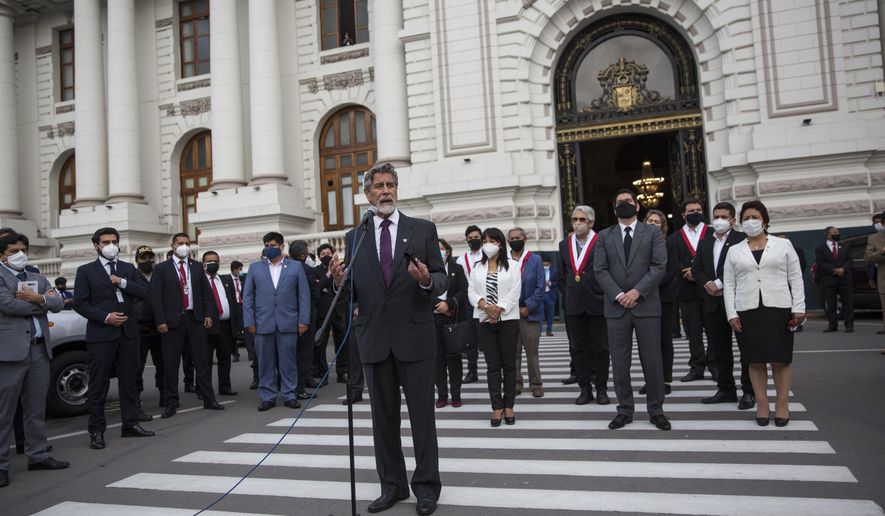LIMA, Peru (AP) - Peru swore in its third president in just over a week Tuesday in a televised ceremony that residents of the fraught South American country watched with both hope and skepticism after the worst constitutional crisis in two decades.
Donning the red and white presidential sash, Francisco Sagasti promised to restore trust in government and paid homage to two young men who died during protests that erupted last week when Congress voted to oust a popular predecessor.
“We can’t bring them back to life,” he said. “But we can stop this from happening again.”
In Lima, many said they were cautiously optimistic the elder statesman could steer the county back to stability after a week of upheaval. But Sagasti has a steep road ahead.
Young Peruvians still angry at a government they see as self-interested and corrupt marched in the capital after the ceremony. Congress remains full of squabbling political parties that have pushed two presidents out in the course of one five-year term. And Sagasti has just five months in office before the presidential election.
“In my 63 years I’ve never seen a good president,” said Victor Mezzarina as he stood outside Congress offering to exchange the Peruvian currency, the sol, for dollars. “I hope this one is different.”
Peru plunged into turmoil last week when Congress voted to oust ex-President Martín Vizcarra. Protesters filled the streets, decrying the move as a parliamentary coup. Legislators swore in a little-known politician and rice farmer as the country’s interim leader. But he resigned five days later after most of his Cabinet resigned and the demonstrations turned violent.
For more than 24 hours, Peru had no designated president.
An engineer by training, Sagasti became Peru’s chief of state a day after being voted in as the leader of Congress. Because Manuel Merino had no vice president when he resigned Sunday, that made Sagasti next in line. He is a respected scholar whose works include a book titled, “Democracy and Good Governance.” In 1996, he was among those taken hostage by Tupac Amaru rebels at the Japanese ambassador’s residence in Lima.
Sagasti’s reputation as a consensus builder makes him an apt choice for the moment, said Michael Shifter, who is head of the Inter-American Dialogue think tank and knows the new president.
“He always had ideas about trying to build bridges in Peru,” Shifter said. “That’s what he really stood for.”
The 76-year-old centrist lawmaker spent the initial hours after being becoming head of Congress on Monday visiting hospitals where injured protesters were recovering and promising to do everything in his power to bring hope back to Peru.
He reiterated that message in his speech Tuesday, vowing to rename a presidential scholarship in honor of Peru’s youth. He praised protesters for reminding politicians of the democratic values they are sworn to uphold. And he promised to continue the fight against corruption.
“This great movement we have seen in all regions of the country belongs to the youth,” he said.
A biography on Sagasti’s website says he works while listening to classical music, has been married three times and keeps a piece of cardboard from a box of mineral water with the signatures of his former Tupac Amaru captors on a wall.
“It was an interesting experience,” he says of his captivity in the text.
Still, for many Peruvians he is a relative unknown, one more in a steady succession of presidents generating frustration, confusion and anxiety. The man Peruvians elected in 2016 - Pedro Pablo Kuczynski - was supposed to be in power until 2021. Instead, repeated corruption scandals and strong arming by Congress has brought the nation four leaders before the term expires.
“For me they’re all the same,” said Ernesto Minaya, 52, a shoe shiner. “I don’t know him.”
As Sagasti was sworn into office, about 100 protesters shouted the names of the two men killed in the protests, Jack Pintado, 22, and Jordan Sotelo, 24, outside Congress. Several thousand later marched through Lima demanding justice for the dead protesters and calling for a new Congress and constitution.
“If there’s no justice and no reconciliation we can’t build a better country,” said Jorge Quinteros, 23.
Sagasti voted against Vizcarra’s ouster - a move likely to win him at least some backing from those who took to the streets in protest. Unlike Vizcarra, he also has a party representing him in Congress. Analysts believe the legislature will still try to stymie any major reforms - particularly to combat corruption - but will have a harder time removing him.
Lawmakers used a 19th century-era clause to oust Vizcarra for “moral incapacity,” accusing him of taking bribes years ago when he was a governor. Vizcarra denies the allegations. The country’s highest court is evaluating whether Congress acted legally. Their ruling is not retroactive but could have an influence going forward.
For many, the ordeal was a blatant display of why Peru’s political system needs reform. No party has a majority in Congress, making building consensus a challenge. Many of the politicians have little experience - and about half are under investigation. They also wield enormous power and can oust the president with a two-thirds majority vote.
Every living former Peruvian president is being investigated or has been charged with corruption. And yet, despite the turmoil, the country has been one of the strongest economic performers in Latin America. The pandemic, however, has thrown Peru’s economy adrift. The International Monetary Fund projects a 14% decline in GDP this year.
“I think this is the end of that kind of coexistence between dismal politics and sound economy,” Shifter said.
As she perused the tabloid headlines Tuesday, Ana Lizardo, 61, said she was somewhat confident Sagasti might be a break from the past.
“At my age I’ve seen many presidents and they’ve all been corrupt,” she said. “I hope he’s better.”




Please read our comment policy before commenting.